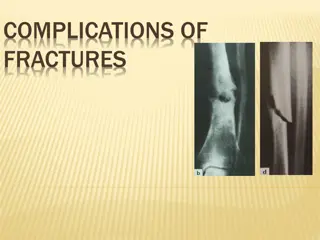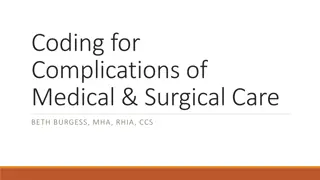Understanding Common Labor Complications and Management Options
Labor and birth processes are typically straightforward, but complications can arise, such as failure to progress, fetal distress, excessive bleeding, malposition, prolapsed umbilical cord, cephalopelvic disproportion, and uterine rupture. Management strategies include rupturing membranes, pain relief, oxytocin stimulation, and operative delivery if necessary. Fetal distress may require repositioning, stopping oxytocin infusion, and monitoring fetal heart rate for possible Caesarean section delivery.
Download Presentation

Please find below an Image/Link to download the presentation.
The content on the website is provided AS IS for your information and personal use only. It may not be sold, licensed, or shared on other websites without obtaining consent from the author. Download presentation by click this link. If you encounter any issues during the download, it is possible that the publisher has removed the file from their server.
E N D
Presentation Transcript
Common labor complication The labor and birth process is usually straight forward, but sometimes complications arise that may need immediate attention. Complications can occur during any part of the labor process.
Common labor complication 1.Failure to progress 2. Fetal distress 3.Excessive bleeding 4.Malposition 5. Prolapsed umbilical cord 6 . cephalopelvic dis proportion 7 . Uterine rupture
1. Failure to progress: Prolonged labor, labor that does not progress, or failure to progress is when labor lasts longer than expected. Causes -slow cervical dilations -slow effacement- - large baby- - small birth canal or pelvis -delivery of multiple babies -emotional factors, such as worry, stress , and fear -Pain medications can also contribute by slowing or weakening uterine contractions.
Management 1. Rupture of Membranes artificially using a tool made for that purpose. 2. pain relieving drugs ,suggest that consider pain treatment , such as an epidural.. 3. Oxytocin is a natural stimulant of the uterine muscle contraction 4. Delivery Options If labor does not progress despite other efforts, or if the baby starts showing signs of distress, operative delivery will take.. Assisted vaginal delivery may be an option in situations where the baby is almost out of the birth canal during the pushing stage. A vacuum or forceps can be used to help the baby come out.
2. Fetal distress "Non-reassuring fetal status," previously known as fetal distress, is used to describe when a fetus does not appear to be doing well. Non-reassuring fetal status may be linked to: 1. an irregular heartbeat in the baby 2. problems with muscle tone and movement 3. low levels of amniotic fluid causes : -insufficient oxygen levels -maternal anemia -pregnancy-induced hypertension in the mother -intrauterine growth retardation (IUGR) -meconium-stained amniotic fluid
Management 1. Turn the mother onto her side to correct any supine hypotension (a low blood pressure which some pregnant women can develop in late pregnancy when they lie flat on their back). 2 .If the woman is receiving an oxytocin infusion, this must be stopped immediately to prevent any uterine overstimulation. 3. If the fetal heart rate returns to normal, allow labor to proceed, but monitor the fetal heart rate very carefully and frequently. If possible, monitor with a CTG. If the fetal bradycardia persists, the fetus must be delivered as soon as possible, which will be by Caesarean section in most cases. While preparing for Caesarean section, fetal resuscitation must be performed.
3. Excessive bleeding On average, women loss( 500 ml) of blood during the vaginal delivery of a single baby. single baby, during the first hour after delivery. hemorrhage result from a lack of uterine tone. Bleeding happens after the placenta is expelled, because the uterine contractions are too weak and cannot provide enough compression to the blood vessels at the site of where the placenta was attached to the uterus.
Risk factors: -previous history of hemorrhage. -labor augmented with oxytocin. -multiple gestation pregnancy -pregnancy-induced hypertension -prolonged labor -the use of forceps or a vacuum-assisted delivery -use of general anesthesia or medications to induce or stop labor -infection -obesity
mangment - assessment post delivery uterine contraction -uterine massage- -removal of retained placenta- -assessment amount and color of vaginal bleeding -monitor VS every 15 minute -IV administration of oxytocin
4. Malposition. not all babies will be in the best position for vaginal delivery. Facing downward is the most common fetal birth position, but babies can be in other positions. They include: -facing upward -breech, either buttocks first (frank breech) or feet first (complete breech) -lying sideways, horizontally across the uterus instead of vertically
Depending on the position of the baby and the situation, it may be necessary to: manually change the fetal position- -use forceps -carry out an episiotomy, to surgically enlarge the opening -perform a cesarian delivery
5.Prolapsed umbilical cord descend of the umbilical cord to the vagina before the presenting part risk factor -multiple pregnancy -high presenting part -polyhydramnios -malpresentation -premature labor -fetal abnormalities
Management 1. use of trendeleburgs position 2. monitoring FHR 3. pushing of the head up and of the cord with a sterile gloved hand.
6. Cephalopelvic disproportion Cephalopelvic disproportion (CPD) is when a baby's head is unable to fit through the mother's pelvis. causes: -the baby is large or has a large head size -the baby is in an unusual position -the mother's pelvis is small or has an unusual shape. A ClS delivery will normally be necessary.
MANAGEMENT 1. Increase pelvic diameter during labor by squatting, sitting ,rolling from side to side 2. maintaining knee-chest position ,use of labor ball 3. CPD may make ClS only available method of birth. 4. monitor maternal VS 5. Monitor FHR.
7. Uterine rupture If someone has previously had a cesarian delivery, there is a small chance that the scar could open during future labor. If this happens, the baby may be at risk of oxygen deprivation and a cesarian delivery may be necessary. The mother may be at risk of excessive bleeding. Apart from a previous cesarean delivery, other possible risk factors include: -the induction of labor- -the size of the baby -maternal age of 35 years or more -the use of instruments in vaginal delivery.
Signs -an abnormal heart rate in the baby -abdominal pain and tenderness in the mother -slow progress in labor -vaginal bleeding -rapid heart rate and low blood pressure in the mother. -hypovolemic shock in the woman, fetus, or both.
Nursing management, 1. delivery by cesarean birth is indicated. The life-threatening nature of uterine rupture is underscored by the fact that the maternal circulatory system delivers approximately 500 mL of blood to the term uterus every minute (Toppenberg & Block, 2002). Maternal death is a real possibility without rapid intervention. 2. Newborn outcome after rupture depends largely on the speed with which surgical rescue is carried out. 3. Monitor maternal vital signs and observe for hypotension and tachycardia, which might indicate hypovolemic shock. 4. Assist in preparing for an emergency cesarean birth by alerting the operating room staff, anesthesia provider, and neonatal team. 5. Insert an indwelling urinary (Foley) catheter if one isn t in place already
References: 1. Clinical Practice Guidelines on Intrapartum and Immediate Postpartum Care 2012 by Department of Health and Philippine Obstetrical and Gynecological Society. 2. Callahan, T. (2013). Blueprints Obstetrics and Gynecology. (6thed.). Baltimore, MD: Lippincott William & Wilkins. 3. Pillitteri, A. (2010). Maternal & Child Health Nursing: Care of the Childbearing and Childrearing Family (6th ed.). PA: Lippincott William & Wilkins.

























